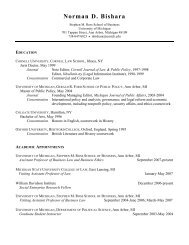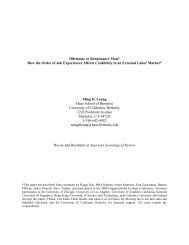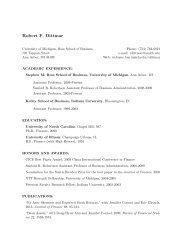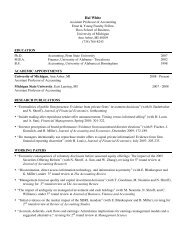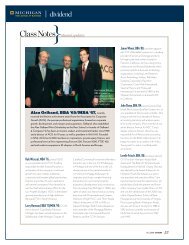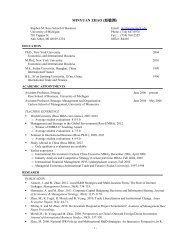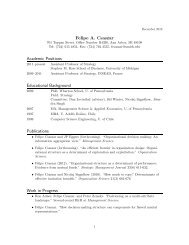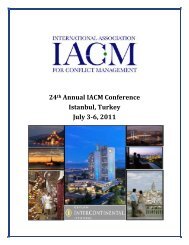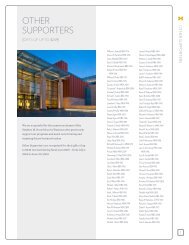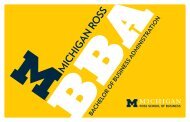DIvIDEnD - Stephen M. Ross School of Business - University of ...
DIvIDEnD - Stephen M. Ross School of Business - University of ...
DIvIDEnD - Stephen M. Ross School of Business - University of ...
You also want an ePaper? Increase the reach of your titles
YUMPU automatically turns print PDFs into web optimized ePapers that Google loves.
photo by max s. gerber<br />
a:<br />
She’s not running her own business or managing<br />
a fledgling startup, but Atisa Sioshansi,<br />
BSE ’97/MSE ’97/MBA ’04, feels every bit<br />
the entrepreneur. She is a strategy expert<br />
inside the global, diversified healthcare giant<br />
Baxter International Inc. The job requires the mindset<br />
<strong>of</strong> a maverick and demands intellectual tenacity,<br />
agility, and resilience.<br />
“there are a number <strong>of</strong> ways to define entrepreneur,” sioshansi<br />
says. “the connotation usually is somebody who starts their own<br />
business. to me, it’s people who are creative and innovative in<br />
different ways, and who learn to take advantage <strong>of</strong> opportunities.”<br />
as group manager <strong>of</strong> strategic initiatives for Baxter’s medication<br />
delivery division, sioshansi is one <strong>of</strong> those innovative opportunists.<br />
Being a problem solver and generator <strong>of</strong> new ideas inside<br />
a massive corporation has taught her that all big business is not<br />
created equal.<br />
“Baxter really stood out from an intrapreneurial standpoint,”<br />
she says. “it has the right innovation culture for me. there is no<br />
day-to-day routine for me in my current role. i might be working<br />
on divisional initiatives, or projects that are more like business<br />
development, or reviewing our R&D portfolio. it’s very much based<br />
on how we look at opportunities to grow our business.”<br />
PUTTinG THE “i” in EnTREPREnEUR sioshansi came to Baxter<br />
with a resume that featured experience ranging from global megafirms<br />
to startups. she worked at Procter & gamble and 3m after earning<br />
her master’s degree in chemical engineering. then she worked for<br />
a venture-backed startup and an early-stage company. while at <strong>Ross</strong>,<br />
she investigated venture capital as a member <strong>of</strong> the student-run<br />
wolverine venture fund, which invests in early-stage companies.<br />
sioshansi says Baxter <strong>of</strong>fered the kind <strong>of</strong> unique career development<br />
opportunities that synthesized the scope <strong>of</strong> her interests.<br />
one <strong>of</strong> the most appealing was a rotational marketing program that<br />
spanned the company’s different divisions and products, including<br />
medical devices, pharmaceuticals, and biotechnology. the program<br />
gave her broad exposure to strategic and tactical marketing.<br />
“it is a large company, but it felt very similar to <strong>Ross</strong>,” she says.<br />
“you can follow a standard path, but there’s also a lot <strong>of</strong> room<br />
for people who see opportunities within the company to start new<br />
initiatives.”<br />
During the marketing rotation program, sioshansi worked with<br />
teams launching new products in latin america and asia and led<br />
a product launch in argentina. the position required the skills<br />
any entrepreneur would need: understanding the target market’s<br />
needs and constraints, listening to local customers and executives,<br />
and knowing which resources would be needed and how to access<br />
them. she also had to keep abreast <strong>of</strong> local healthcare policies and<br />
practices in the respective markets.<br />
“you have to look at how they are spending their money and<br />
what the needs and opportunities are,” sioshansi says. “it varies<br />
country by country. i think there are a lot <strong>of</strong> people who aren’t<br />
successful in these markets because they go in with ideas on how to<br />
enter without truly understanding the market needs. what helped<br />
me succeed was listening, understanding the dynamics, and then<br />
being able to relate to their needs.”<br />
THAT’S A PlAn like any good intrapreneur, sioshansi currently<br />
is nurturing a plan that is technically outside the scope <strong>of</strong> her job.<br />
and while she can’t reveal specifics, she describes the developing<br />
project as a “venture-type initiative.”<br />
she has invested much time and energy in finding enough people<br />
— and the right people — to support the idea, despite a harsh economic<br />
climate. “you certainly learn how to persevere during tough<br />
times, and right now i think it’s a tough time,” sioshansi says. “you<br />
learn how to deal with somebody saying no. Do you reprioritize or<br />
find other investors and supporters?”<br />
time is split between her regular duties and this intrapreneurial<br />
venture, and sioshansi acknowledges that she may not be able<br />
to actualize her vision as quickly as she could inside a small firm.<br />
“you have to accept that you’re not going to move at the speed <strong>of</strong><br />
light and that there are certain processes and approvals you need<br />
to get,” she says. “there are also competing plans. to the leadership,<br />
this proposal makes sense on a certain level, but whether we<br />
should put it into action at this time is another matter. i have to<br />
make it fit in a changing landscape. sometimes i need to be patient<br />
and learn to let it baste.”<br />
finding the right corporate culture at this point in her career<br />
delivers the best <strong>of</strong> both worlds for sioshansi. “an entrepreneurial<br />
mindset is ingrained regardless <strong>of</strong> what kind <strong>of</strong> organization<br />
you’re in,” she says. “these experiences are more important to me<br />
than the need to go after the title <strong>of</strong> ceo or vice president in the<br />
next five years. i have a long-range goal <strong>of</strong> doing venture capital<br />
in the healthcare industry, and i’m gaining valuable experience<br />
right now.” —Terry Kosdrosky<br />
spring 2010 <strong>DIvIDEnD</strong> 35



